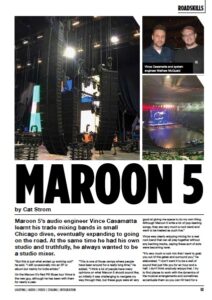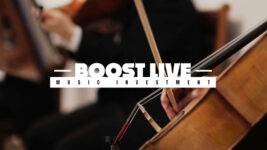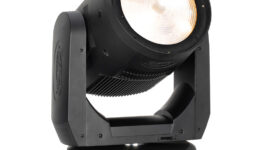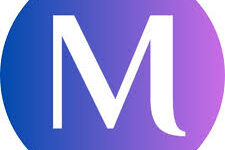News
2 Apr 2019
Maroon 5
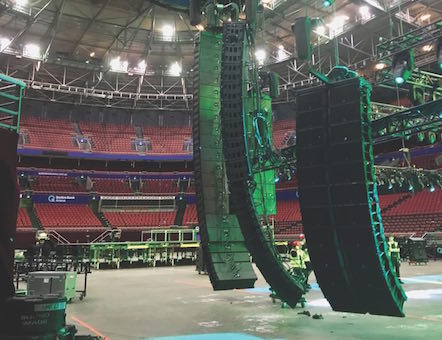
Subscribe to CX E-News
ROADSKILLS
Maroon 5
by Cat Strom.
Maroon 5’s audio engineer Vince Casamatta learnt his trade mixing bands in small Chicago dives, eventually expanding to going on the road. At the same time he had his own studio and truthfully, he always wanted to be a studio mixer.
“But this is just what ended up working out!” he said. “I still occasionally mix an EP or album but mainly for indie artists.” On the Maroon 5’s Red Pill Blues tour Vince is the new guy, although he has been with them for nearly a year.
“This is one of those camps where people have been around for a really long time,” he added. “I think a lot of people have many opinions on what Maroon 5 should sound like, so initially it was challenging to navigate my way through that, but these guys were all very good at giving me space to do my own thing.
“Although Maroon 5 write a lot of pop-leaning songs, they are very much a rock band and want to be treated as such live.”
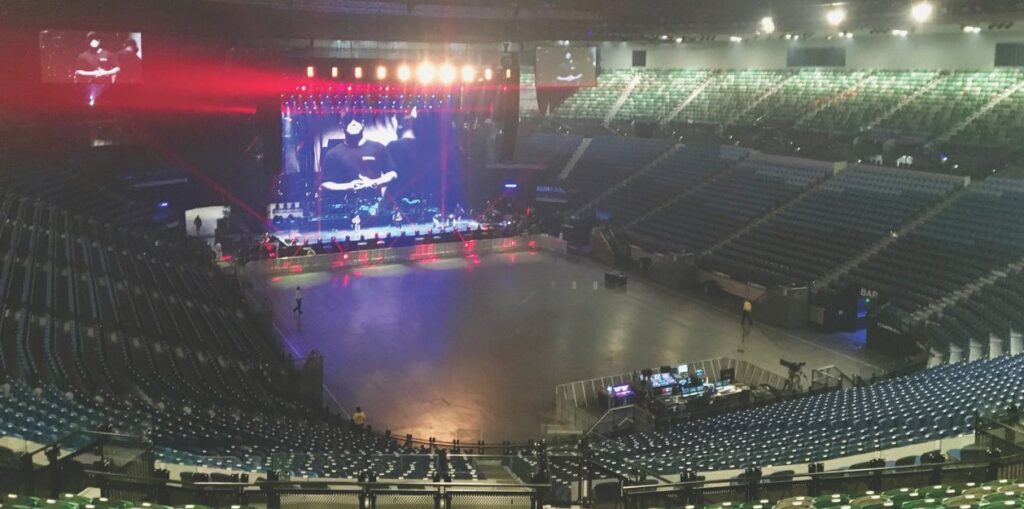 Vince was clearly enjoying mixing for a real rock band that can all play together without any backing tracks, saying these sort of acts were becoming rarer.
Vince was clearly enjoying mixing for a real rock band that can all play together without any backing tracks, saying these sort of acts were becoming rarer.
“It’s very much a rock mix that I want to grab you out of the gates and surround you,” he elaborated.
“I don’t want it to be a wall of sound that just hits you for an hour and a half. I don’t think anybody enjoys that. I try to find places to work with the dynamics of the musical arrangements and sometimes accentuate them so you can hit hard for a bit and then pull back.
“These guys are really aware of those things anyway with their set list choices and live arrangements, I’m just trying to present that the best way I can.”
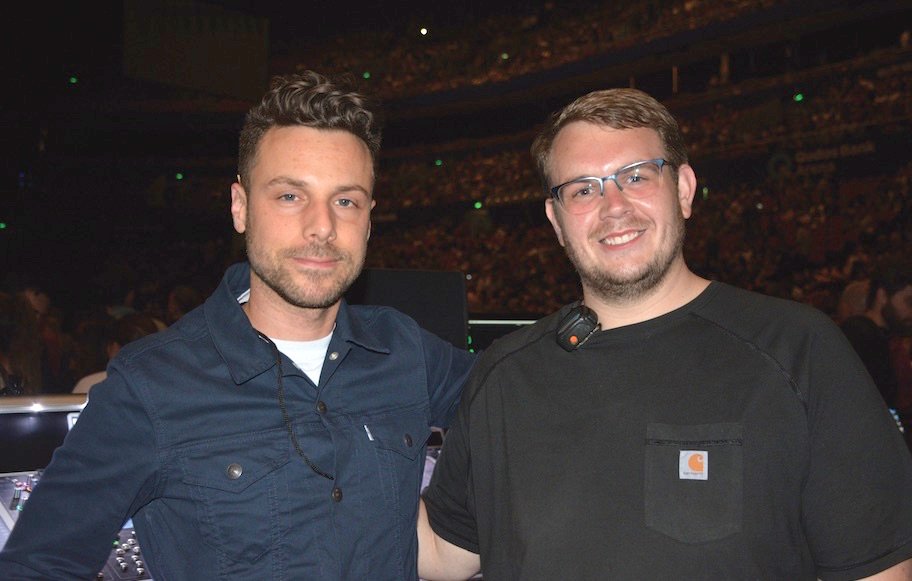
Audio engineer Vince Casamatta (L) and Systems engineer Mathew McQuaid
As a fan of DiGiCo consoles, Vince opted for an SD5, favouring its work flow and complexity. As well as some outboard gear, he had a Waves SoundGrid server running up on the SD5, with anything that needs to be automated going on the server and anything that is static for the entire show in his outboard rack.
The Waves plugins are used mainly for group compression and parallel compression, which gave the mix flavour and texture as the DiGiCo is such a neutral surface to begin with, according to Vince.
“The API 2500 is a great compressor and the SSL Quad compressor is always good to add parallel compression to drum busses,” added Vince.
“I really like the API 560 EQ plugin on the kick and snare buss; as it’s a live drummer his dynamic changes throughout the set, and the API 560 allows me to re-tailor how the drums are sitting in the mix on the fly.”
“On the road, you don’t know what kind of support you’re going to have so I like to keep things as simple as possible so if things go wrong, you can troubleshoot them easily,” he said.
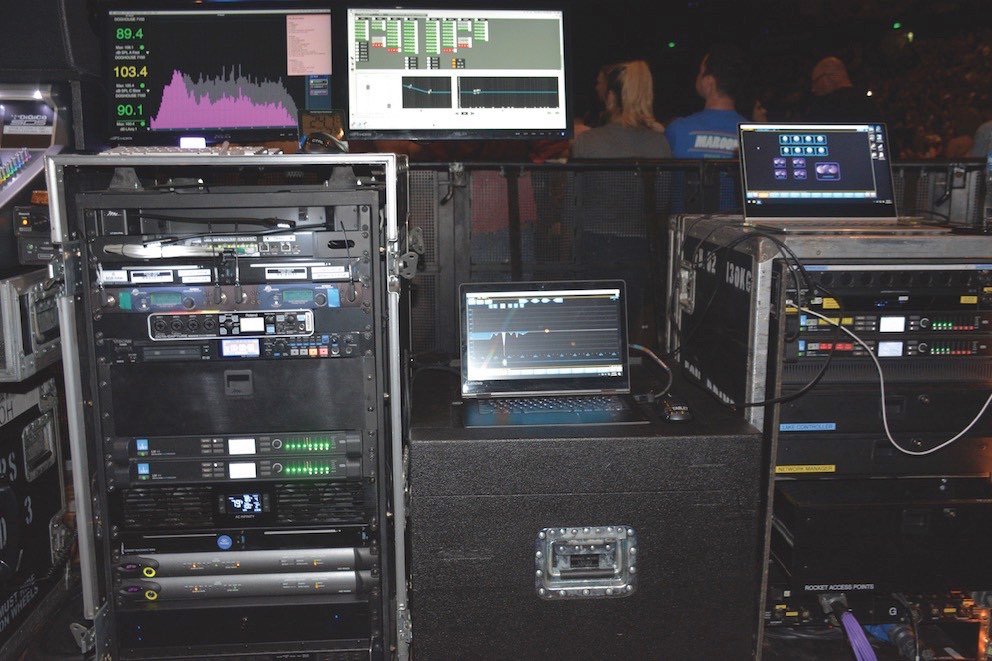 Outboard gear included a Bricasti M7 for Adam’s main effect reverb with Vince using MIDI triggers from the snapshots to change patches in the Bricasti.
Outboard gear included a Bricasti M7 for Adam’s main effect reverb with Vince using MIDI triggers from the snapshots to change patches in the Bricasti.
A Tube-Tech CL 2A is used for a compressor on Adam’s vocal and spare vocal, whilst a Neve 5045 primary source enhancer saves Vince a few headaches as most of the show designs feature Adam in front of the PA for nearly the entire set. However in Australia the set was scaled back with a design that kept Adam behind the PA.
“He’s always in a different place with respect to the PA. L-Acoustics being so tonally linear as you walk through it is helpful but the Neve 5045 is super helpful,” explained Vince.
PA was an L-Acoustics K1/K2, K1 main and sides with K2 below with the sub configuration often changing depending on the venue.
“We are flying K1 for main and side hangs with K2 below, so that we keep the coverage consistent close to the stage,” explained Vince.
“Rear hangs are almost always K2 only. K1SB are always flown directly behind the main K1 hang for added low extension and punch. We also use a cardioid sub arc on the floor. All powered by LA12s wherever possible.
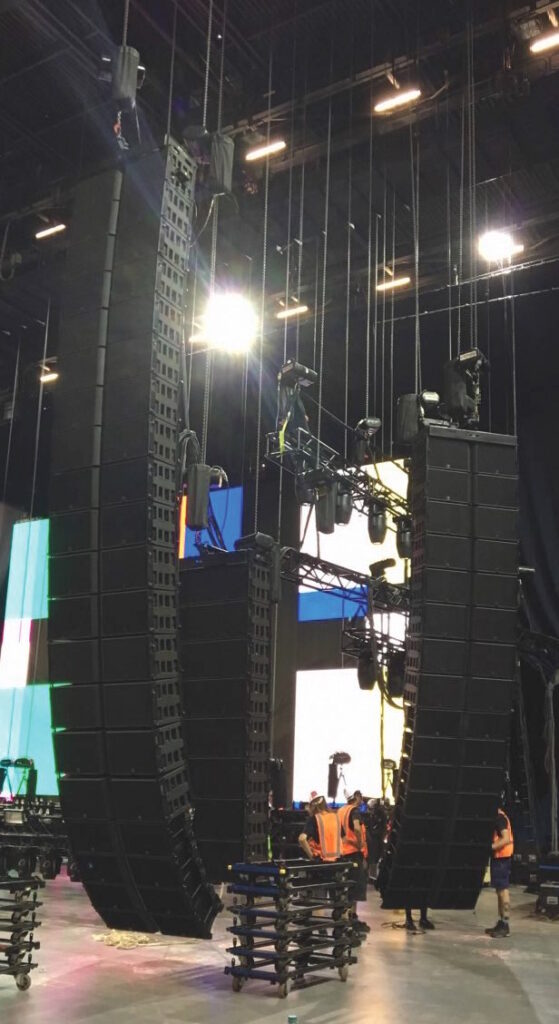 “One of our main concerns in design is how to keep low end off the deck so the band aren’t rattling around up there. Mathew McQuaid is responsible for overseeing the entire design process and has done a great job of maximizing FOH coverage while nulling the low end on the deck.”
“One of our main concerns in design is how to keep low end off the deck so the band aren’t rattling around up there. Mathew McQuaid is responsible for overseeing the entire design process and has done a great job of maximizing FOH coverage while nulling the low end on the deck.”
Systems engineer Mathew McQuaid used Soundvision, L-Acoustics’ proprietary acoustic prediction software, and Rational Acoustics Smaart 8 to align the system each night.
“There are a lot of good PAs on the market and you can have a great show with many of them,” said Vince.
“This is the most vocal forward mix I have ever had and the L-Acoustics has made me feel like I’m not fighting myself as far as where the vocal sits in the mix. I want a really cool, rock-sounding mix but I don’t want to sacrifice the fact the vocals have to be over top, in fact the vocal presence has been pretty easy to dial in.”
The band are Shure endorsees with lead singer Adam Levine using the Shure Axient system and singing into a black SM58, a no frills approach that Vince admires and although Adam beats the mic and tosses it into the crowd every show, it always holds up.
“It’s the right approach to pick a microphone that is tried and true, meat and potatoes, nothing fancy as he basically uses it for everything but a hammer,” laughed Vince.
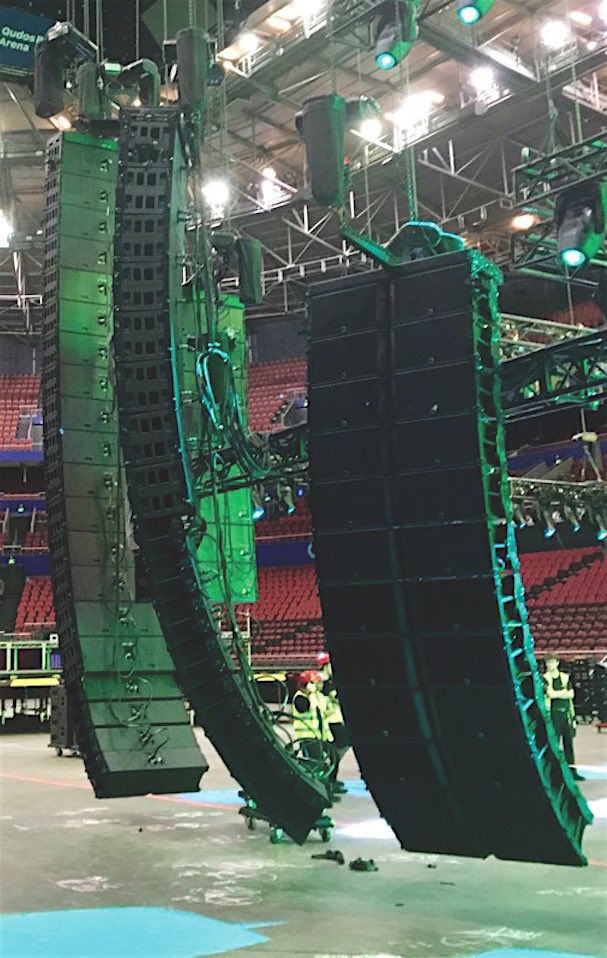 “With this show, I have been less concerned with microphones than with other acts and I don’t really know why that is. I have the new D12 kick mic, a dynamic microphone that, when supplied with phantom power has a few different EQ curves.
“With this show, I have been less concerned with microphones than with other acts and I don’t really know why that is. I have the new D12 kick mic, a dynamic microphone that, when supplied with phantom power has a few different EQ curves.
“I have a 57 on snare top which sounds great, all no frills. If you have a good band with good tones and a great mixing console, a lot of it is just getting out of the way and letting it happen.”
The band changed a lot of the guitars to Fractals from Royer Ribbon mics, which Vince says sound way better and sit in the mix well taking up less headroom. With seven people on stage headroom becomes a real challenge quickly.
Monitor engineer Bill Chrysler mixed on an Avid VENUE S6L-32D with the latest version of Waves SoundGrid. Most of the plugins he used were in the console, with the exception of Adam Levine’s vocal reverb, which is a Waves TrueVerb.
Everyone has both IEMs and wedges, except the bass player who has no IEMs and Adam who only has IEMs.
“The wedges help to retain a bit of vibe onstage as stages become quieter and more isolated, it’s a way for the band to feel connected,” commented Vince.
JPJ Audio supplied the tour.
From CX Magazine – April 2019 CX Magazine is Australia and New Zealand’s only publication dedicated to entertainment technology news and issues – available in print and online. Read all editions for free or search our archive www.cxnetwork.com.au
© CX Media
Subscribe
Published monthly since 1991, our famous AV industry magazine is free for download or pay for print. Subscribers also receive CX News, our free weekly email with the latest industry news and jobs.

